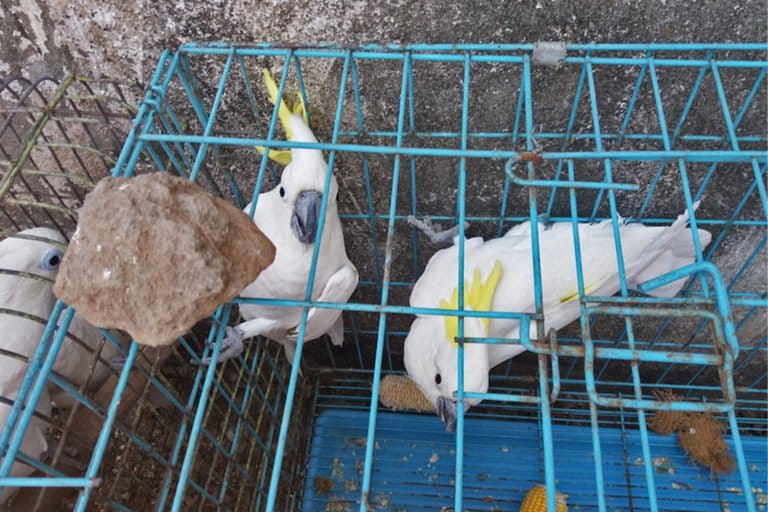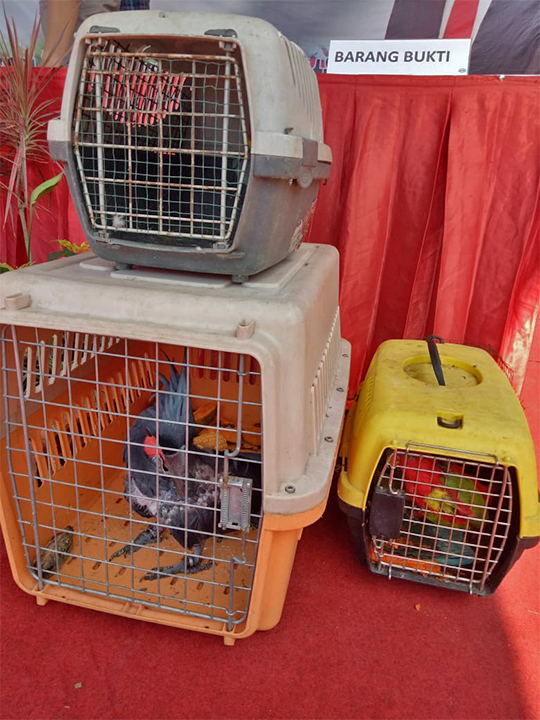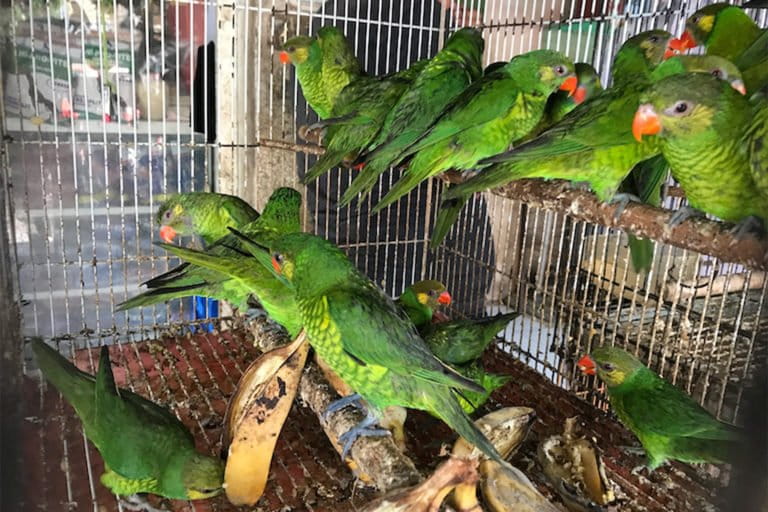CSI, but for parrots: Study applies criminological tool CRAAVED to wildlife trade
Jun 7, 2021
- Parrots as the most traded animal taxon have the potential to provide a primary source of data for investigating the causes and consequences of the animal trade.
- A new study applies the CRAAVED model analysis to shed new light on key drivers of the illegal parrot trade in Indonesia, home to the highest diversity of the birds and a thriving wildlife market.
- The analysis identified three main factors for which species were targeted by traffickers: how accessible parrot species are to people and traders; whether legal export of the species is possible; and whether the species is enjoyable through its color, size or mimicry.
- Other experts have welcomed the findings and their implications, but point to limitations in the CRAAVED model and the importance of considering other factors such as harvest quotas and the motivation behind wildlife crime.
Parrots, inhabiting pan-tropical and temperate regions across the world, are highly sought after as pets due to their attractive colors, calls and clever nature. But some of the trade in these birds involves the illicit market, a significant concern with nearly one-third of the 400 known parrot species at risk of extinction.
A recent study published in Biological Conservation applies a criminological model known as CRAAVED to shed new light on key drivers of the illegal parrot trade in Indonesia. The country has the highest diversity of parrot species, with 89 currently recorded, including the critically endangered yellow-crested cockatoo (Cacatua sulphurea), endangered purple-naped lory (Lorius domicella), and vulnerable salmon-crested cockatoo (Cacatua moluccensis).
CRAAVED is an acronym for seven factors influencing wildlife trade: concealable, removable, accessible, abundant, valuable, enjoyable, and disposable. Originally developed in the 1990s, the model is used to help understand theft variation of commonly stolen products; in this case, parrots. According to the study, parrots form the most traded animal taxon, and therefore may provide “some of the best sources of data for investigating the causes and consequences of the animal trade.”
The research team used six market and seizure data sources collected over a period of two decades, 1997 to 2018, from six provinces across Indonesia. The data sets indicated consistent trends in illegal trade practices for parrot species common to each province.
Through the application of the CRAAVED model, the multinational research team identified three main factors that explained the differences between how and why certain species were targeted more than others in Indonesia: how accessible parrot species are to people and traders; whether the species is disposable, or whether legal export of the species is possible; and finally, whether the species is enjoyable through its color, size or mimicry. More recent data (2012-2018) also indicated that more concealable species were targeted compared with species that could not be legally trapped and were thus harder to conceal from law enforcement.

Lead author Stephen Pires, a criminologist at Florida International University, said the study could set a precedent for the researching and monitoring the illegal pet and plant trades.
“The CRAAVED model is a useful tool to understand why some species are traded or poached more often than others by taking into consideration all factors that may play a part, and this is especially the case for the live pet trade,” he said.
Co-author George Olah, a conservation biologist at Australian National University, told Mongabay that CRAAVED is a model that is easy to apply and highlighted some important elements of the parrot trade, such as that the more humans are present in an area, the higher the probability of nests being poached. It also showed that stronger law enforcement is urgently needed.

Olah said studies like this are important tools in the regulation of the wildlife trade, especially as official crime and environmental data are often limited in some countries. “Local authorities like the police and the forestry department collect very important data around the wildlife trade in Indonesia, however these are often just stored as non-analyzed internal reports,” he said.
“With this study and our local collaborators, we hope to show a useful example for the local authorities about the importance and utility of these data, and prompt them to analyze them or collaborate with local and international scientists in this field.”
Vincent Nijman, an anthropologist at Oxford Brookes University, has studied the illegal wildlife trade in Indonesia. A bird market survey he contributed to in 2015 formed part of the Biological Conservation study and was cited in the piece.

Nijman told Mongabay that from his reading of the paper it “overall provides a good analysis of the parrot trade in Indonesia and gives some new insights into what drives the trade.”
However, Nijman queried two elements of the study.
First, he said one of the data sets was a potential outlier. While other data sets rely on bird market surveys, Nijman said the study includes a household survey where researchers recorded the number of pet parrots kept by people in North Maluku province. Nijman noted he does “not think these data are comparable,” and that other, more relevant studies, or local studies, could have been used.

Nijman said he’s also concerned that the study does not discuss harvest quotas — that is, population estimates used to set a limit for how many individuals from a species can be harvested for market trade. Their absence might affect the definition of a species as protected or not.
“For the majority of parrot species there is no harvest quota or the numbers we see in trade are substantially higher than what is legally allowed to be traded,” he said. “Thus, the authors considering a species ‘protected’ or ‘not protected’ is too simplistic.”
He added, “While I agree with the authors that not all ‘captive-bred’ parrots have been bred in captivity — rather they are taken from the wild — there is a legal captive-bred trade in ‘protected’ species.”

Olah told Mongabay that the team considered including harvest quotas, but these are controversial and opted not to use them in the final analysis.
“In general, harvest quotas were published yearly by LIPI, the Indonesian Institute of Sciences, and in years when numbers were published, it was legal to trade up to the number defined in the quota,” he said. “However, the numbers traded often exceeded the defined quotas, and we did not have a good record of what quotas were published per year per species.” As a result, the research team defined protected species based on the national red list.
Given the study’s multidisciplinary approach, Mongabay also sought comment from Tanya Wyatt, a specialist in green criminology at Northumbria University. She said the CRAAVED model provides a useful tool to unpack some of the factors that contribute to illicit trade and likely has uses beyond the illegal pet trade.

“The study seems robust with numerous datasets over an extended period of time,” Wyatt said. “The CRAAVED model, however, does not get at the motivations behind wildlife crime, which is knowledge that is critical to reduce the loss of individual non-human life and biodiversity.
“The opportunity and demand factors do not explain why offenders take advantage of opportunities to poach or why an attractive pet is desirable,” she added.
Wyatt said CRAAVED is a piece of a larger puzzle in tackling wildlife crime in the future.
Citation:
Pires, S. F., Olah, G., Nandika, D., Agustina, D., & Heinsohn, R. (2021). What drives the illegal parrot trade? Applying a criminological model to market and seizure data in Indonesia. Biological Conservation, 257, 109098. doi:10.1016/j.biocon.2021.109098
Chng, S. C., Eaton, J. A., Krishnasamy, K., Shepherd, C. R., & Nijman, V. (2015). In the market for extinction: An inventory of Jakarta’s bird markets. Retrieved from TRAFFIC website: https://www.traffic.org/site/assets/files/2466/market_for_extinction_jakarta.pdf